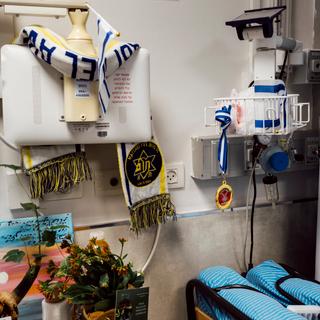


Wounded Israeli soldiers recount their war in Gaza: 'They killed five, we killed five'
FeatureThe Israeli Ministry of Defense acknowledges that 60 soldiers are being injured every day. But support for military operations in the Palestinian enclave remains massive among the Israeli population.
In his wheelchair, Noam's legs were often crossed, and part of them was missing – his right leg was amputated below the knee. This was due to a homemade bomb as his unit advanced through an urban area in northern Gaza on November 16. Cheerful despite his mutilation, the 20-year-old Israeli was not given permission to be more specific in these interviews with soldiers selected by an army spokesperson. Nevertheless, the conversations give an idea of the violence of the war – the deadliest of this century according to British NGO Oxfam – which has been ravaging the Gaza Strip for almost four months. Some 25,000 Palestinians have been killed, 70% of them women and children. Meanwhile, 219 soldiers have lost their lives, the worst toll in the country's recent history. It's a war being waged far from view: Since October 7, Israel has forbidden free access to the press in the enclave.

Noam took part in the early fighting. He had completed more than two years's military service, with the 53rd Battalion of the 188th Armored Brigade, when Hamas launched the October 7 attack that killed 1,140 Israelis. His unit was sent to the south of the Gaza Strip, next to the Egyptian border. "There were many dead, Israeli civilians as well as terrorists. We fought as best we could. It was a real war," recalled the soldier, who served on a Merkava 4 tank, the latest model of Israeli tanks. On October 27, the ground offensive began. Noam's unit was deployed two weeks later to support the advance of ground units.
"We were moving down a street, between two rows of buildings. There were civilians around us, including a mother and daughter. Suddenly, a terrorist emerged from a house and placed a homemade bomb to the right of our tank. We didn't see him, but the tank behind us did. He tried to fire, but the gun jammed. The charge exploded, wounding me and the tank's gunner. I stayed calm. I applied a tourniquet. As for my comrade, he was hit in the lower part of his body, right down to his stomach. His entrails were protruding through a gash. But he pulled through."
'Human shields'
Noam described tough fighting, carried out in the midst of numerous civilians, "whom Hamas uses as human shields, to give us a bad name." We shouldn't expect these soldiers to question a war massively supported by the Israeli population. According to a recent poll, conducted by Tel Aviv University in January, 82% of those surveyed believed the army was using adequate – or too little – firepower.
The young man will have to wait for the wound to heal before a prosthesis can be fitted. A wounded nation is wandering the corridors of Sheba Medical Center's rehabilitation ward. Young people move around in wheelchairs, walkers and crutches. On Monday, the Ministry of Defense told a Knesset committee that its rehabilitation department was treating 4,544 members of the security forces. On average, 60 soldiers are being injured every day. Israel's largest facility has had to convert a floor and a half of its geriatrics department to accommodate the soldiers.
You have 60% of this article left to read. The rest is for subscribers only.
